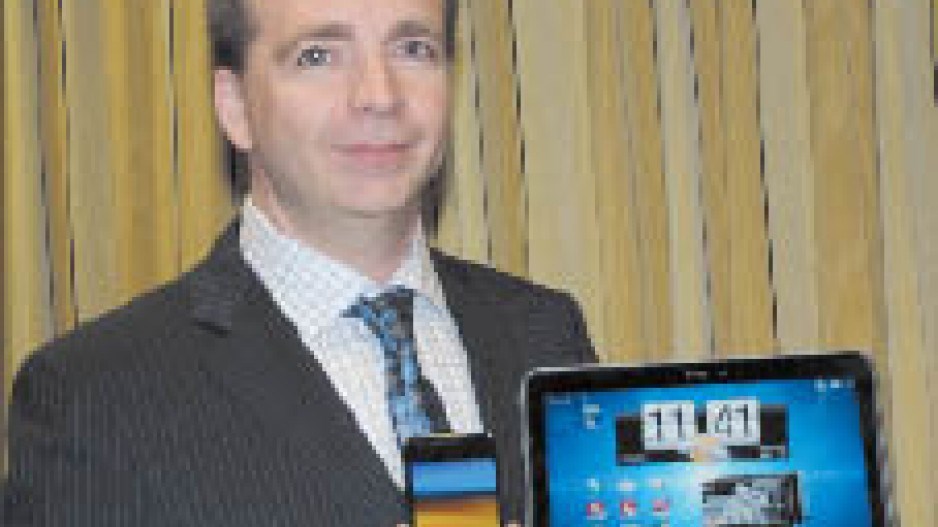If you use any kind of a mobile device, you’ve probably heard about LTE and how fast it is.
Rogers Communications Inc. (TSX:RCI) demonstrated just how fast last week at the launch of Vancouver’s first LTE (long-term evolution) cellular network.
It also showcased a new LTE-compatible, Android-based Samsung smartphone and HTC tablet that will be available soon.
“It gives us the ability to serve more people in the same geographic area with higher speeds and a better user experience,” Reade Barber, senior director, data product management for Rogers, said at a media launch last week.
Vancouver joins Toronto and Montreal as the only Canadian cities with Rogers’ LTE network.
Bell launched LTE in the Hamilton-Waterloo area two weeks ago, and Telus is busy installing the equipment needed to launch LTE early in 2012.
Only Vancouver, Burnaby and Richmond are currently in Rogers’ LTE coverage area. Other outlying cities will be added as the necessary infrastructure is built.
LTE’s data speeds have thus far only been available on high-speed Internet. In addition to speed, LTE has better latency (less lag, for things like gaming).
Rogers’ LTE’s downlink speeds are four to five times faster than anything currently available. Users will be able to watch HD movies, play games and transfer huge amounts of data on a smartphone, tablet or laptop.
There’s just one hitch: whatever smartphone or tablet you own now won’t work on the LTE network. Those devices need to be built specifically for LTE, and, so far, few manufacturers are making them.
The first LTE-capable smartphone that Rogers will sell is the Samsung Galaxy II ($199 on a three-year plan or $650 with no plan).
The new HTC Jetstream tablet – exclusive to Rogers – is scheduled to be available October 18 and will sell for $500 on a three-year plan or $800 without a plan.
Among the tablet’s features is a digital pen that will allow users to sketch, highlight, take notes and sign documents.
As for data plans, Rogers is offering a limited introductory offer of a 10 gigabyte (GB) “bucket” for $52.93 per month.
Most initial customers are not likely to be smartphone or tablet users, but businessmen and women who need high-speed cellular connections for their laptops.
For that, Rogers sells a mobile modem called the LTE Rocket, as well as a Rogers wireless AirCard, both of which are made by Richmond’s Sierra Wireless, which also makes the LTE-capable USB modems for Bell and AT&T in the U.S.
“This is a milestone in a pretty significant piece of work to get this technology out there,” said Andrew Green, Sierra’s vice-president of marketing, mobile computing business unit.
“LTE is a pretty massive technical challenge. It’s something we’ve been working on for a number of years now, and this sort of technology is rolling out around the world in bits and pieces and Rogers is really on the leading edge of that.”
The LTE Rocket powers a user’s laptop, while the AirCard turns it into a cellular mobile hotspot that up to five devices can use.
Mark Golberg, a telecommunications industry consultant, said the early adopters are likely to be the corporate sector and added that Rogers might score points for being among the first to offer LTE.
“It’s an important statement to their corporate clients,” Goldberg said. “Rogers has been fairly strong in the corporate market.”
He described a typical corporate user: A salesperson flying from Toronto to Vancouver to make a presentation could use an LTE modem to download graphics, sound and video files for a PowerPoint presentation in mere seconds while in the air or in a taxi.
“I think the message is that wireless competition isn’t just a matter of who’s got the lowest price,” Goldberg said. “It’s also Rogers sending a signal to its customers and the marketplace that quality and innovation are important characteristics for people to consider when choosing their carrier.”
If Apple is planning to launch LTE-capable iPhones, iPads and MacBooks, the company isn’t saying. However, it is planning a major announcement next week and some analysts are speculating the company plans to announce LTE-capable iPhones and iPads for 2012.
LTE networks use existing fibre optic infrastructure, but require billions of dollars of upgrades in the form of new antennas and other hardware. Telus spokesman Shawn Hall said the company is investing $670 million in B.C. alone this year, a significant portion of which is going into LTE infrastructure. •




